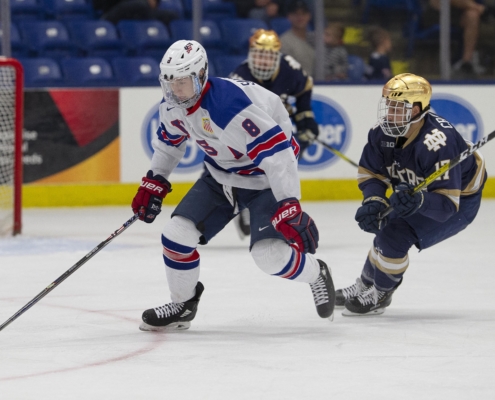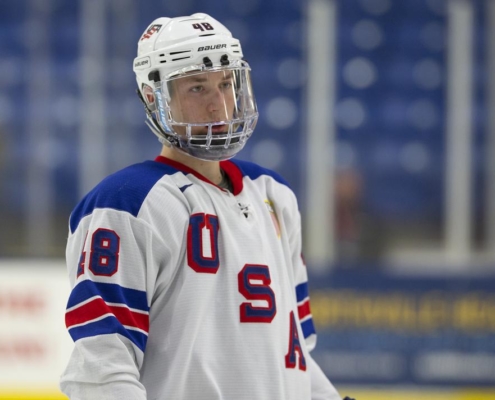H2H: Jamie Drysdale vs. Jake Sanderson
Steve Kournianos | 4/24/2020 | Nashville | [hupso]
NASHVILLE (The Draft Analyst) — There’s never been a draft in any sport that didn’t have some type of headline-grabbing “who’s better” argument that grew more raucous as the big day drew near. Most of those debates are not only legitimate but also add to the intrigue behind every draft, especially when it comes to the first overall pick. Thanks to Alexis Lafreniere’s ridiculous draft season with Rimouski in the Quebec League, however, there is no doubt whom the first pick in 2020 will be. What happens thereafter is another story, as Sudbury’s Quinton Byfield — as talented and promising a prospect as he may be — no longer has a stranglehold on the No. 2 position, let alone challenge Lafreniere for the top spot.
Nonetheless, these developments have helped shift pre-draft disputes away from the first overall pick and more towards an interesting debate over the top defenseman from this forward-heavy Class of 2020. Erie’s Jamie Drysdale, a Canadian-born puck rusher who plays for the Ontario Hockey League’s Erie Otters, has long been considered the most impressive rearguard among his peers and was the preseason favorite to become the first defenseman taken in 2020.
Not only can Drysdale skate like the wind, but he also carries the puck-carrying load on a thin team and has played with distinction for Team Canada at multiple international tournaments. For the first half of this season, finding a challenger to knock Drysdale off his seemingly comfortable position atop every major draft ranking seemed fruitless. Especially in early January after he impressed in a limited role for Canada at the high-profile under-20 world junior hockey championship.
Not long after what many considered to be Drysdale’s peak performance of his draft year, however, a challenger suddenly emerged.
Fueled by an incredible run of dominant league play, a standout performance at the All-American Prospect Game, and a shellacking of Europe’s top draft prospects at the February U18 Five Nations tournament, Jake Sanderson of the U.S. National Team Development Program suddenly became Drysdale’s primary pursuer. Of course, it’s not as if Drysdale was ready to abdicate his position, as both he and Sanderson were equally impressive in their leadership roles for their respective teams from wire to wire.
Still, the draft can be full of surprises. Although Drysdale is ahead of Sanderson on most mainstream lists, the fact that the NHL’s Central Scouting Bureau shot Sanderson up to fourth overall in their final rankings (one slot behind Drysdale) adds another layer or intrigue to a debate that wasn’t much of a debate four or five months prior.
So what’s the deal? Is Drysdale versus Sanderson your typical pre-draft hype generated by the media to attract attention? Or is it the ever-common “recency bias” when scouts start to favor the players on hot streaks at season’s end over those who began strong? As you’ll see below, this debate is not only legitimate, but far from some media creation — both Drysdale and Sanderson are cornerstone pieces with immense potential; both of whom are worthy to be a top-five pick in this year’s draft.
Player Data
Jamie Drysdale
Position: Right-handed Defenseman
Shoots: Right
Height / Weight: 5’11, 175 lbs
Born: April 8th, 2002 | Toronto, ON
Nation: Canada
Stats
| Opponent | GP | G | A | PTS | SOG |
| OHL | 49 | 9 | 38 | 47 | 136 |
| International | 14 | 1 | 9 | 10 | 8* |
*Hockey Canada never tracks shot totals for the Hlinka.
Jake Sanderson
Position: Left-handed Defenseman
Shoots: Left
Height / Weight: 6’2, 185 lbs
Born: July 8th, 2002 | Whitefish, MT
Nation: United States
Stats
| Opponent | GP | G | A | PTS | SOG |
| NCAA | 18 | 0 | 4 | 4 | 19 |
| International | 8 | 4 | 4 | 8 | 11 |
| USHL | 21 | 3 | 14 | 17 | 44 |
| Totals | 47 | 7 | 22 | 29 | 74 |
Head to Head
Skating
Sanderson and Drysdale both have explosive first steps and long, clean strides, although Sanderson displays more power while Drysdale is more graceful. Trying to guess who would win in a head-to-head foot race at this stage is impossible because both have elite straight-line speed. People might lean towards Drysdale because he’s wiry and looks like a blur out there, but those same people probably slept on Sanderson’s quickness in the first place. Either defender can go coast to coast while making sharp directional changes at top speed.
In terms of balance, neither Sanderson nor Drysdale lack in that department. Sanderson, however, is impossible to knock off the puck when standing still, let alone at top speed. He also absorbs hits better than any No. 1 defensemen in his class. Drysdale relies more on his speed and agility to avoid close contact, but he can be shoved off the puck or knocked down far easier than Sanderson.
Agility-wise, the edge has to go to Drysdale. The way he walks the line and uses fakes, only to drop a nasty directional change and head for the goal, is beyond elite — you can feel a checking forward’s anxiety if he’s tasked to cover Drysdale’s side, or at least trying to cover him. Both Sanderson and Drysdale are elusive, but Drysdale’s escapability is on another level. Forechecking either one of these studs is best performed with a sizable cushion in between, so chasing them behind the net is useless unless there is a trap established to fix one of them into a forced pass or turnover. Thing is, they deliver timely first passes with authority, so two forecheckers committed to containing either Drysdale or Sanderson usually get trapped a good 20-40 feet behind the play.
Winner: Tie
Shooting
Drysdale’s combined shot power, shot release, and ability to create his own shot while using his feet to improve his angle is the best in the draft class, and possibly the best in the OHL since Ryan Ellis almost a decade ago. And that isn’t a jab at either Tony DeAngelo or Ryan Merkley, it’s just that Drysdale’s ability to combine an explosive shot with gazelle-like speed is something only a few defensemen can do. Drysdale is deadly from the high slot but he also is confident to wire a wrister labeled for the upper half when acting as the spearhead of an odd-man rush.
Sanderson has a hard slapper and has scored with his wrister from long distances, so he’s definitely no slouch in that regard. His has very good accuracy and will get pucks on net with traffic in front on the regular. Unfortunately, the NTDP has always been a forward-centric attack, even in a season like 2020 when Sanderson was the top draft prospect on the team. What that means is the presence of a high-volume shooter on the NTDP’s back end is a rarity, so keep that in mind when looking at Sanderson’s pedestrian shot totals (only 74 in 47 games, compared to Drysdale’s 136 in 49 matches)
Winner: Drysdale
Passing/Playmaking/Vision
One of the methods I use to label a draft stud as “elite” is the amount of time it takes for me to realize which skill is their most impressive. If it’s February and I still can’t decide between skating or playmaking, chances are that kid will end up in my elite category. Such is the case with Drysdale, because not only does he blow you away with speed and shot generation, but he also is a fantastic passer.
There was one game where Drysdale was surveying the neutral zone while off the puck and slowly retreated towards his line. In the blink of an eye, Drysdale exploded to the opposing blue line to collect a loose puck, and instead of taking the puck into the zone with speed as most would have assumed, Drysdale stopped at the line and wheeled a no-look dart toward the middle that caught a forward in stride for a break-in. So many aspects of a prospect’s skill set came into play for that to happen — reads, anticipation, quickness, confidence, vision, passing — a collection of attributes that can define a defenseman’s hockey sense and also the ability to process multiple decisions in split-second intervals.
Sanderson’s highlight reel is a collection of high-IQ plays, but you’re going to have to forgive him if it doesn’t include as many mind-blowing setups as Drysdale’s. He delivers a clean, crisp first pass and makes perfect cross-ice feeds on either his forehand or backhand, which helps him run the power play. Like Drysdale, Sanderson is both confident and accurate when delivering passes across the seam. It’s just that Drysdale seemed to do it more often.
Winner: Drysdale
Defensive Coverage
There’s really no other way to put it — Sanderson is well ahead of Drysdale when it comes to neutralizing opposing rushes and covering his side of the ice like a blanket. Part of this can be explained by the fact that Sanderson played regularly against tougher, faster, and older NCAA competition, whereas Drysdale’s OHL in 2020 was a free-wheeling track meet on a nightly basis.
Sanderson’s gap control is close to impeccable. He keeps it short and rarely affords the puck carrier the chance to take him inside. Experienced NCAA skaters with speed had more success doing this earlier in the season but Sanderson seemed to make adjustments to fix them to the outside as the season progressed. Therein lies the rub for opponents, as beating Sanderson to the outside is dangerous from both a turnover and bodycheck standpoint. The result appeared to be a lot more chip-and-chases, which when dealing with a fast-skating and quick-thinking defenseman is going to yield suboptimal results for the attacker.
Drysdale gets challenged to the inside a lot more than Sanderson and it shows. Although he has a very quick stick and impressive acceleration in his backwards crossovers, Drysdale can be standoffish at his line and keeps a longer gap, albeit with proper stick-on-puck technique.
In terms of slot coverage, Drysdale is a bit of a roamer. Always looking to dart into an opening for a counterattack, he will vacate the slot quite frequently and get caught chasing around as high as the blue line. Sanderson is less inclined to vacate the danger areas, but one must also consider the plethora of hard-nosed, two-way forwards on the NTDP versus the type of forward support Drysdale gets with Erie.
Winner: Sanderson
Smarts (Poise, Reads, and Anticipation)
As mentioned before both players are incredibly intelligent and have performed with aplomb under the intense pressure of international tournaments and best-on-best showcases.
Drysdale and Sanderson are sharks in the neutral zone and pick off a lot of lazy passes. Turning on the switch from defense to offense comes with ease and their decisions off the puck yield more successes than failures. With Drysdale, he uses a variety of methods beyond his speed to beat back pressure. Not only is he poised enough to delay for at least a full second to fake a double team towards the opposite direction, but he also leads his support with the softest of touches. A key consideration when assessing Drysdale’s riverboat gambling is the type of partner he’s flanking. His primary on Erie’s top pairing was 2000-born lefty Jack Duff, a towering hulk who is the quintessential stay-at-home type. Drysdale also saw time with veteran big boys Drew Hunter, Kurtis Henry, and Jacob Golden. You get the sense that roles were clearly defined regardless of Drysdale’s partners — Jamie goes and goes while the others stay.
Sanderson had a stronger supporting cast up front so breakouts were not entirely on his shoulders. His chemistry with partner Eamon Powell helped make timing plays work to perfection and they executed a lot of give-and-go’s that obviously required thought and snap risk assessments. Sanderson definitely has an acute sense to not only sense pressure coming from his six but also knows where support will be and who is the smartest option to pass to. Sanderson rarely flinches first when a speedy forechecker comes barreling towards him and he’ll eat the puck rather than pass to a covered teammates to save his own keister.
Winner: Tie
Physical Play
This result is probably the most lopsided of any category, as Sanderson is not only stronger, thicker, and hits harder, but he also has the intimidation factor. Additionally, Sanderson put NCAA opponents on notice with his bone-crunching, open-ice hits, and those very opponents were no slouches — Boston University, North Dakota, Providence, etc. One major consideration here is the timing of Sanderson’s hits — he rarely delivers a wallop solely for the sake of delivering a wallop, thus exposing his side of the ice. A lot of Sanderson’s bigger hits this year were dished out while defending against a zone entry or popping a guy with his head down during a cycle.
Sanderson also battles hard for low-slot positioning. Any opponent who tries to establish a net-front presence is going to deal with Sanderson in a lengthy, sometimes violent, one-on-one battle.
Drysdale isn’t much of a hitter and he resorts to a hard shoves more than anything. Unlike Sanderson’s on-ice presence, opposing forwards can skate towards Drysdale’s direction without the worry that their melon will be knocked into next week. He doesn’t seem rattled when targeted by a heavy forecheck and is willing to take a hard hit to complete a play.
Winner: Sanderson
Power Play
Quarterbacking a successful power play is the mark of a superior offensive defenseman, but you might have to forgive Drysdale and Sanderson’s for their respective team’s anemic totals with the man advantage. Neither Erie nor the NTDP were among the top half of their league’s leading power plays, but it’s hard to find fault in only one player.
Sanderson and Drysdale both operated in four-forward power plays but share different responsibilities when their team is up a man. Drysdale with Erie is the focal point of everything, from retrieval to breakout to zone entry and finally up to play execution inside the offensive end. The story’s a little different with Sanderson, who is capable of running the show from start to finish but has multiple forwards to defer to for playmaking responsibilities. As the season progressed, however, Sanderson’s top teammates such as Thomas Bordeleau and Brett Berard were willing to acquiesce puck-controlling duties inside the zone and allow Sanderson to get creative. This was starkly apparent in the second half of the the NTDP’s season.
Winner: Tie
Penalty Kill
The beauty of playing in a program like the NTDP is that each roster is loaded with versatility, thus giving the head coach multiple options to choose from when it comes to special teams or specific situations. Sanderson was a constant on the penalty kill, to include 5-on-3’s against, and was the first one summoned as long as the previous shift permitted it. He stayed on the left side and had a steady rotation of righty partners, but it seemed like the pairing of Sanderson and Brock Faber were the team’s most effective. We’ve already detailed Sanderson’s defensive-zone play and slot coverage, so it goes without saying that he can be a pain in the neck to play against with the man advantage. His feet are quick and his stick is very active, and Sanderson has even shoved net-front forwards away from the crease and into a teammate create a turnover. He also seems to have good communication with his goalies to avoid unnecessary screens.
Drysdale, like Sanderson, also had the luxury of teammates who specialize in situations like the PK. Although Drysdale was used on the kill with regularity, he was not the first option and even saw Duff used with others to form the Otters’ preferred shutdown pairing. Roaming from the slot was a constant but having a static safety net like Duff, Henry, or Golden likely dictated Drysdale’s desire to chase the puck and look to head up ice shorthanded. Still, Erie had one of the OHL’s best penalty-killing units and Drysdale played a big part in that.
Winner: Sanderson
International Events
Both Drysdale and Sanderson have represented their respective nations in key tournaments in each of the last two seasons.
Drysdale played for Team Canada at the 2018 World U17 Hockey Challenge (4 assists in 5 games), the 2019 under-18 World Championship (2 assists in 7 games), the 2019 under-18 Ivan Hlinka Tournament (5 assists in 5 games), and most importantly, the 2020 under-20 World Junior Championship (1 goal, 2 assists in 7 games), which is a rare spot for 17-year-old Canadian defensemen. Drysdale also played for Team OHL against Russia in the U20 Super Series (1 assist in 2 games)
Sanderson, like most NTDP’ers, is no stranger to international competition as he appeared in a total of five major events in the last two seasons. He was one of the top defenseman at several tournaments such as the 2018 U17 Four Nations (1 goal, 4 assists, and 20 shots in 4 games), the 2019 U17 Five Nations (1 goal, 3 assists, and 13 shots in 4 games), and the 2020 U18 Five Nations, where he tied for the overall lead in scoring (3 goals, 4 assists in 4 games).
They only time they have met on the same sheet of ice was at the 2018 U17 Hockey Challenge, with Drysdale’s Canada-Black squad coming away with a 5-4 victory over Sanderson and the U17 NTDP. The stream for the game is available here.
One of the bigger casualties from the current pandemic (at least from a draft prospect standpoint) was the cancellation of the U18 world championship that was supposed to take place in Plymouth, Mich. Sanderson and the NTDP were hosting the event and Erie’s expected early-round ouster from the OHL playoffs (had they taken place) would probably have given us a Drysdale-Sanderson matchup if Canada and the U.S. faced off.
What Drysdale was able to reveal in limited minutes at the under-20 world junior championship is what convinced a lot of scouts that he was closer to being a top-5 selection instead of the consensus top 10. Sanderson’s dominance of the USHL schedule, the All-American Prospects Game, and the February Five Nations tournament — all grouped together after the start of the new year — helped validate his potential as a top-5 pick by delivering peak performances when the spotlight shone its brightest.
Nonetheless, as you can see, both defenseman have impressive resumes when it comes to the international stage. The fact that Drysdale was chosen to play for three teams above his age bracket, however, has to give him a slight edge over Sanderson. But get your popcorn ready for late-December 2020 as both should be suiting up for their respective national teams at the World Juniors in Edmonton.
Winner: Drysdale
Conclusion
As close as these two are, the overall edge remains with Drysdale, whose slight advantages in playmaking, vision, creativity, and shot proclivity barely outweigh Sanderson’s superiority on defense and in physical play. As others have pointed out, Sanderson’s frame may make him better suited for the toughness and physicality inherent in NCAA and NHL games. But it’s tough to hit what you can’t catch, and Drysdale has proven he can be just as dangerous and elusive in the half-court game as he is during track meets. Either way, both are obviously special talents and have the potential to carry a franchise.
Winner: Drysdale






